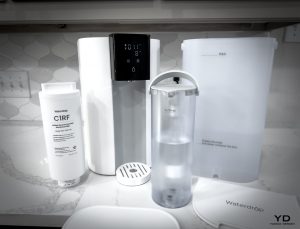SOMMAIRE
If you buy an item via links on this page, we may earn a commission. Our editorial content is not influenced by commissions. Read the full disclosure.
Lately, people are obsessed with ranunculus, and it’s easy to see why.
With many options, from single blossoms to those with masses of petals, and flowers in the palest of pastels to deep reds and purples, this delicate-looking flower has taken gardens and flower farms by storm.
Whether you’re dreaming of vases full of frilly blossoms or a tough little groundcover for your garden, you should be growing ranunculus.
What is Ranunculus?
Ranunculus is a genus in the Ranunculae family that accounts for about 1800 species of plants. These plants are also called buttercups, water crowfoots, figworts, Persian buttercups, and spearworts.
This may be a surprise, but this plant is more than just a great thing to look at. Although all buttercups are considered toxic when ingested, Native Americans used parts of the plant to treat body aches, skin disorders, and diseases.
Although some species are tender perennials that can’t tolerate frost, most buttercups prefer cooler climates in which to bloom. In other words, they like it cold, but not too cold.
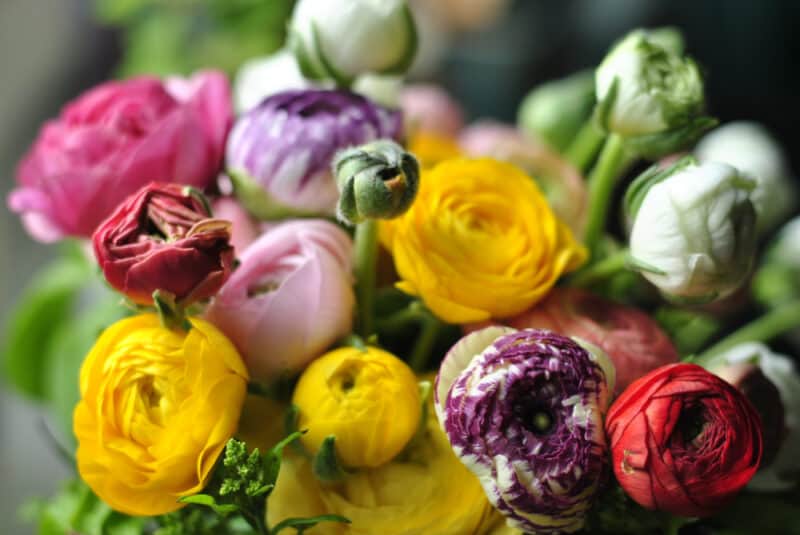
Tender species are often treated as an annual in colder regions but will return in USDA Hardiness Zones 8-10. Other species are hardy all the way down to Zone 2.
Mostly grown from corms, which resemble an octopus at first sight, and they can be grown via seed and dividing the roots, depending upon variety.
Energy returns to the roots and corms as the plant dies back at the end of the season so they can return the following year.
Bloom time is spring to early summer. Species of ranunculus have various bloom times and frequencies, flower shapes and colors, and leaf sizes and shapes.
Many colors are available, some of which are unique from many common flowers. From two-toned color combinations, pastels, and deep and mysterious shades, to vibrant sunny tones, there is an endless selection to choose from.
Top 7 Ranunculus Species to Grow
As we mentioned, there are lots of buttercup species, cultivars, and hybrids. It would take all day to even list them all. Let’s explore ten popular species of ranunculus commonly available.
Persian Buttercup
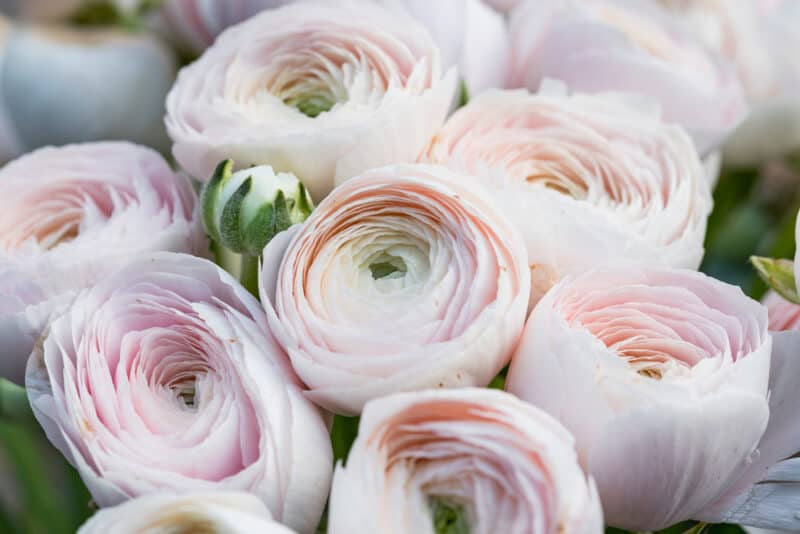
Native to the Mediterranean, southwest Asia, and southeastern Europe, Persian buttercup (R. asiaticus) is one of the most recognized flowers.
Referred to as just ranunculus, it is widely used as a cut flower by flower farmers, florists, and budding growers all over the world.
Blossoms have multiple layers of petals on sturdy 12-24 inch stems. The foliage is bright green and mostly basal in growth. There are a vast number of color tones available, such as pink, red, orange, white, pale yellow, cream, and purple.
Able to grow in pots, particularly if outside of recommended Hardiness Zones, it’s also good in borders and mixed gardens with free draining, moist soil.
Extremely popular for flower arrangements., they have a vase life is up to seven days.
Grow it in USDA Hardiness Zones 8-11, though it can be treated as an annual in Zones 3-7 as long as they are kept cool and away from full sun.
‘Tomer Picotee‘ is a stand-out cultivar with paper-thin, multi-layered blooms. It looks similar to a rose in form and is a highly desired wedding flower.
Picotee is the term used to indicate that the edges a darker tone to the central part of the petal. This flower is a two-toned delight of creamy white to pinky purple edging.
Prolific bloomer and long-lasting, it grows 10-12 inches. Suitable for pots, borders, cut flowers, and height.
The Tecolote series from California features double, peony-shaped flowers. Autumn-planted corms bloom at the beginning of spring, extending to mid-spring if planted later towards the end of fall.
The blossoms come in fairytale pink, salmon, merlot, yellow, and white hues. Strong green basal foliage, 18-24 inches, frequently grown for its cut flower magic.
It tolerates full sun as long as the soil is moist. The corms are prone to rot if water-logged.
‘Amandine Rose‘ is a smaller Persian buttercup with tissue paper-like, multiple-layered petals on 10-15 inch stems. Dark green foliage mainly stems from the base of the plant.
Amandine’s blooming period is later and longer due to its greater heat tolerance. Found in vibrant colors, including purple. Tolerates full sun or partial shade. Hardy to Zones 7-11, it can be an annual in Zones 3-6.
Like giant clouds on a spring morning, Iceberg is heaven-sent. It’s the largest white cloned ranunculus at 12-24 inches tall with flowers that are 3-5 inches in diameter. One plant might have up to 5-10 blooms at a time from spring to early summer.
it has basal greenery, for the most part, but can sprout some leaves near the blossoms. It’s tolerant of partial shade and prefers free-draining soil. Hardy in Zones 7-10, treat as annual Zones 3-6.
Early Buttercup
One of the first to offer flowers in springtime, these small buttercups pack a yellow punch. They’re an excellent plant for rock gardens or small spaces since it can tolerate dry conditions once established.
A lovely ground cover option, early buttercup (R. fascicularis) measures 4-12 inches. The yellow petals almost appear to shine thanks to a reflective coating common to the genera.
It spreads by tuberous roots and reseeds readily if allowed to mature. It’s categorized as a native wildflower in the dry prairies and open woodland areas of eastern North America and Canada.
This is one of the cold-tolerant buttercups, able to thrive in Zones 3-7.
Mount Cook Buttercup
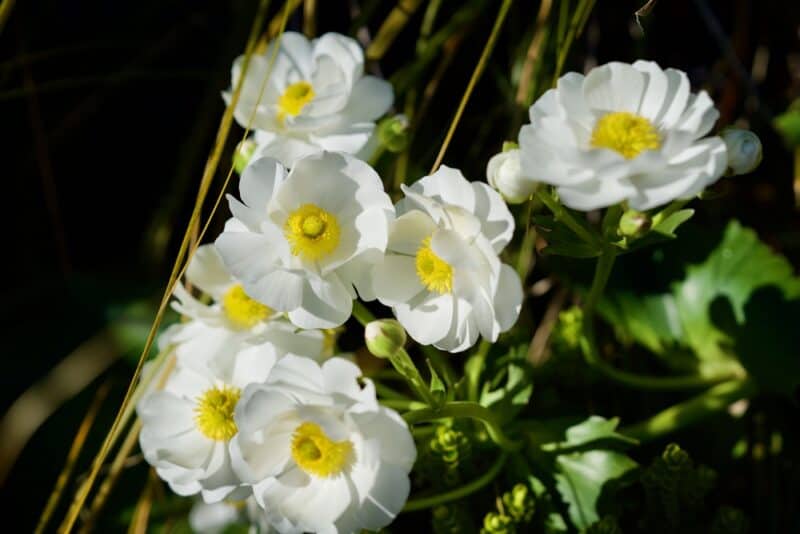
This is the world’s largest buttercup, also known as the giant buttercup and mountain buttercup (R. lyallii). The blossoms on this species are white with a golden yellow center.
Native to the mountains of New Zealand, it was initially called the Mount Cook lily, even though it’s not a lily. It’s cultivated all over the world as an evergreen summer flowering plant.
This plant grows in clumps, reaching one-two wide, and grows between 24-36 inches tall.
Adapted to grow in some infertile hard areas, preferring damp conditions and free-draining soil. This ranunculus does not do well in hot areas. Provides a challenge for the more experienced gardener.
Another cold-hardy species, it will grow in Zones 3-11.
Snow Buttercup
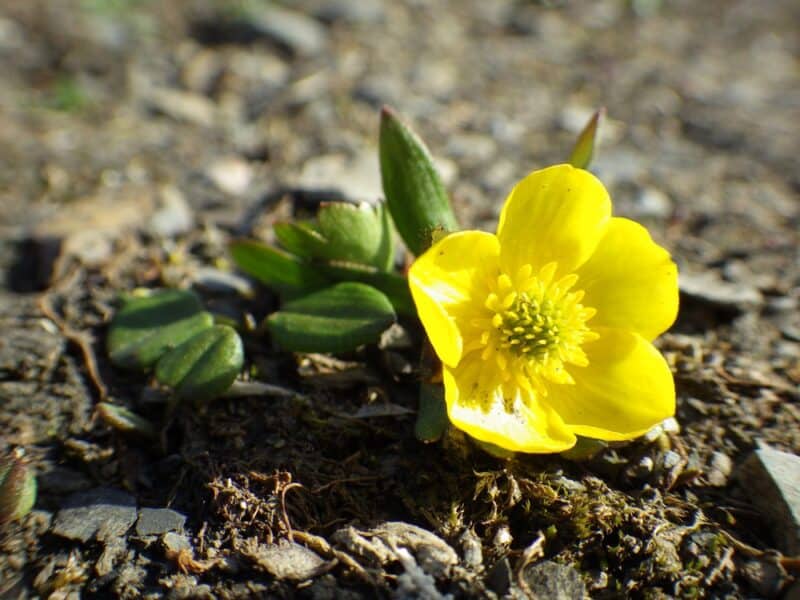
Categorized as a perennial herbaceous ranunculus, snow buttercup (R. nivalis) is commonly found in the Arctic and Alaska, where it starts blooming before the snow completely melts.
Remanent of the traditional buttercup appearance of sunshine yellow. Blooms from June to August. The plant reaches up to six inches in height and ten inches during the fruiting phase.
Allow space once established as it will spread readily. It’s a good ground cover and easy to grow in humus-rich soil and partial shade.
This extremely cold hardy plant is ideal for Zones 2-8.
Italian Ranunculus
Italian buttercups aren’t a species but tissue clones bred in Italy to develop the best characteristics of the Persian ranunculus for cut flower use. They include cultivars like Cloni Success and Elegance Venere.
Elegance Venera has peony ruffled, swirling blooms with a slightly off-tone center on 18-24 inch stems. It’s a totally different floral presentation from the mainstream Persian buttercup.
These are fall-planted and spring-blooming in full sun and well-draining moderately moist soil. Good in USDA Hardiness Zones 8-10.
Canary Buttercup
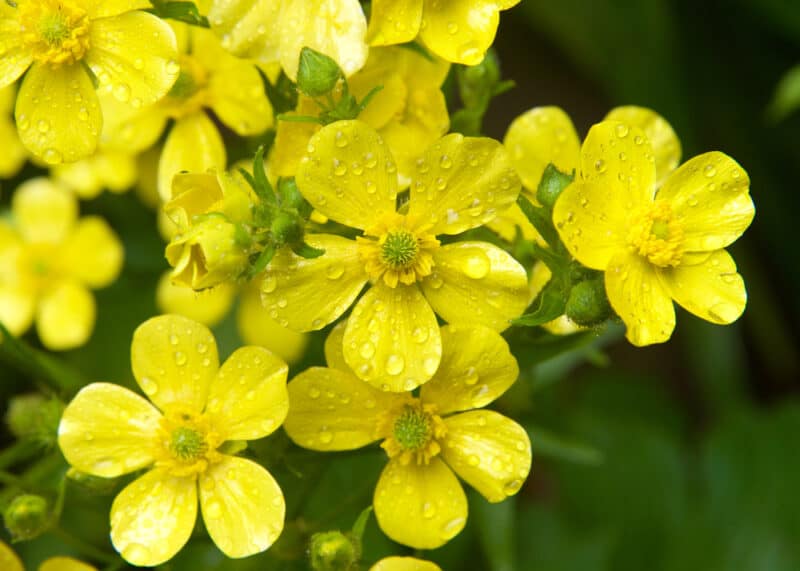
A natural spreading form of buttercup, R. cortusifolius exhibits bright yellow, shiny petals around a small yellow and green center.
It will naturally self-seed through the years if left to mature and prefers some shade and moderately moist soil. It dies back in the fall and returns again when conditions are right.
It has a clumping growth habit of 8-12 inches across. The flowers stand taller than the large basal leaves. Hardy in Zones 8-10.
Lesser Celandine
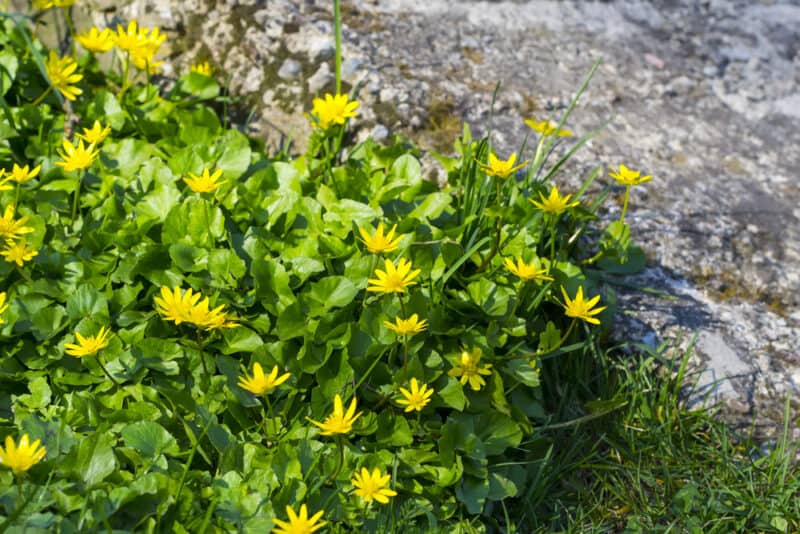
Ficaria verna (formerly R. ficaria) is native to Asia and Europe and has naturalized across North America. It has cheerful yellow blossoms on a carpet of green leaves.
Some varieties and cultivars have mottled cream and green leaves, others have purple leaves. It tolerates seasonal flooding but won’t thrive with constantly wet roots. It grows in Zones 4-9, but be aware that it can be invasive in some areas.
Even though this is no longer considered part of the Ranunculus genus, it’s grown in the same way and looks similar.
Propagating Ranunculus
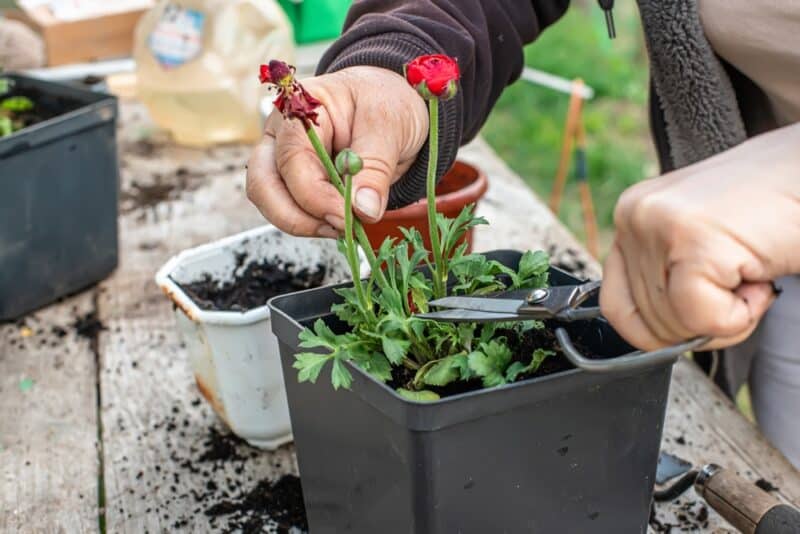
You can grow ranunculus by seed or by planting corms. You can also often find live plants for transplanting at nurseries in the spring.
Growing from Seed
Sow seed in pots filled with a good quality seed starting mix and lightly cover. Keep the soil moist but not soggy as the seeds germinate. Place the container in an area with bright, indirect light.
Germination takes between 20-30 days when the temperature is around 50°F. Protect seedlings from pests and direct sunlight and keep them at a steady temperature of 55°F.
The seedlings need a long, cool period to establish themselves.
Plant outside after a period of hardening off when the seedlings have four sets of leaves and all danger of frost passed. Newly-planted seedlings require protection if there is a brief heat. Cover them with shade cloth during the hottest part of the day.
Remember that seeds may not be replicas of the parent plant if you harvest seeds from your flowers.
Growing from Corms
There are corms that should be planted in the fall and those that should be planted in the spring. Be sure you know which you’re dealing with before you start planting. Spring types generally bloom later, while fall-planted corms emerge earlier.
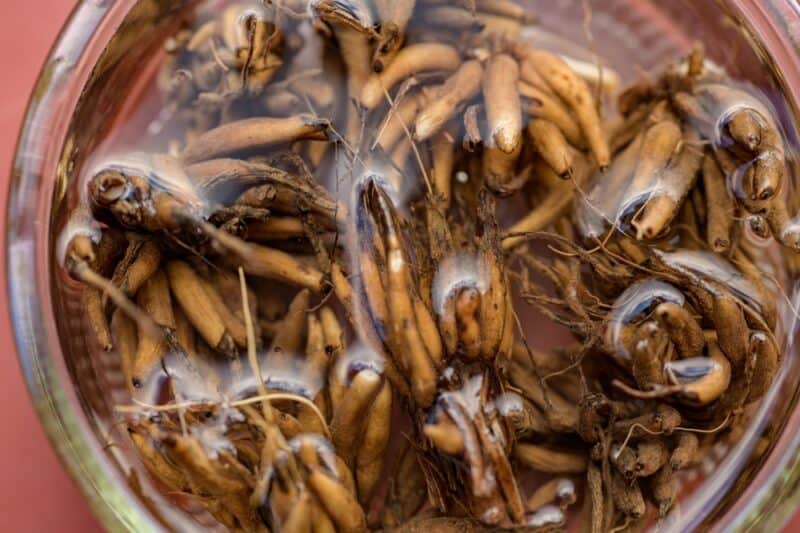
Soak the corms for a few hours in room-temperature water to hydrate them.
At this point, you can either pre-sprout the corms or plant them directly into the soil. Pre-sprouting allows you to determine which corms are dead before you place them in the ground and it gives you a headstart on growing.
If pre-sprouting:
Prepare two inches of seed starting mix in trays or pots. They do not need draining holes. Place corms with their “tentacles” facing down into prepared trays or pots. Cover completely with soil mix.
Place the containers in bright, indirect light in an area that is about 50°F. Water the soil when it’s dry. You want the soil to stay barely moist. Not wet and not too dry. Once every few days, check the corms to see if they’re sending out white roots.
Once you see roots and the weather is right, place the corms in the soil where you intend to grow them.
Most ranunculus shouldn’t go outside until the temperatures are consistently above 45°F.
If direct sowing:
Plant corms three inches deep. Space them according to the species you’re growing.
Corms need temperatures not exceeding 50°F to start sprouting, so plant them out when it’s cold but not freezing. If you don’t typically have this kind of weather, pre-sprout as described above.
Protect emerging growth from extreme temperatures and pests using floating row covers, polytunnels, or cloches.
Use caution not to overwater. The soil should be moist but never wet. Wet soil causes root rot.
Caring for Ranunculus
Most ranunculus need full sun to flower, though some species do better in some shade.
As we mentioned, these flowers thrive in cooler climates. If your pansies are happy, these plants will be, too.
These plants need regular water but will die in soggy soil. Water when the top inch of soil has dried out and aim for a texture that is like a well-wrung-out sponge.
Use a good compost at the time of planting ranunculus and a monthly application of a mild, balanced fertilizer or fish emulsion. Straw or leaf mulch can assist with protection and water retention in warmer months.
All buttercup types are toxic to pets, livestock, and humans, causing skin irritation or stomach upset if ingested.
Corms should be dug up once plants have died back as they will freeze and rot when thawing if left in grounds where temperatures drop below 25°F. Store the corms in dry, dark containers with airflow until you can re-plant them.
Companion Plants.
- Calendula
- Larkspur
- Delphinium
- Snapdragon
- Foxglove
- Sweet Pea
- Iceland Poppy
- Pansies
- Candytuft
- Linaria
- African Daisy
Pests, Problems, and Care
Ranunculus is famous for being fussy and delicate, and that reputation is not entirely unearned. They can be a challenge to grow, and there are lots of pests and diseases that attack them. Let’s talk about herbivores first.
Herbivores
Ranunculus are not generally targeted by rabbits or deer. However, their corms can be a target for moles, and are often dug up by squirrels, mice, and chipmunks.
You can cut out the bottom of plastic plant pots and insert them into the soil surrounding the corm. This acts as a barrier to underground pests.
Or, protect corms and plants by growing in rodent-free areas like a basement or garage initially. That way, they can become established before you set them out.
Pests
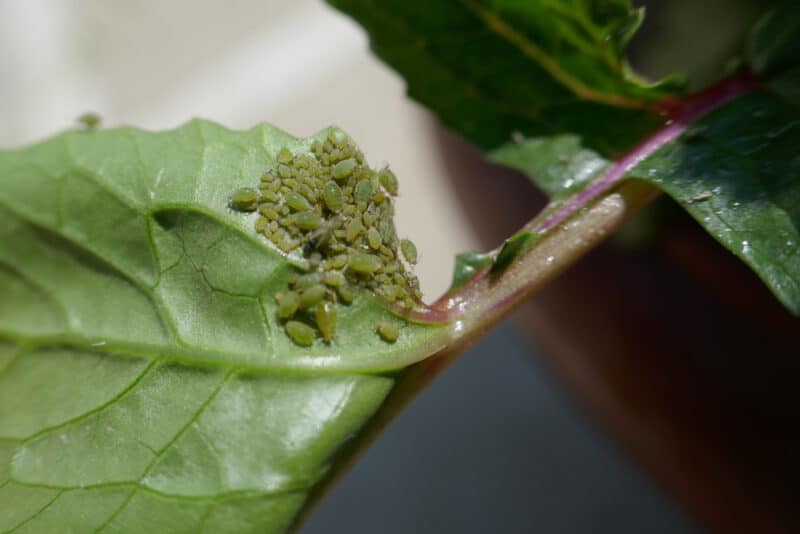
When it comes to pests, aphids, thrips, mealybugs, nematodes, and spider mites are all common.
First signs of aphids, thrips, mealybugs, nematodes and spider mites spray with a good insecticide or homemade equivalent if preferred.
Pests typically become an issue when the ranunculus struggle in hotter months or gardening hygiene becomes an issue.
When ranunculus starts to sprout, they become a beacon for slugs, snails, and birds.
Diseases
Corms can be prone to rot and mold if over-watered at the germination or during growing.
Growing areas must have airflow to prevent fungal disease, and you should keep the plants well-spaced.
These plants are prone to powdery mildew, pythium or phytophthora rot, and botrytis blight.
Spécialiste jardin et bricolage, j’adore rédiger des articles qui aide les lecteurs à améliorer leur maison ! Souvent connecté, n’hésitez pas à poser vos questions !


















